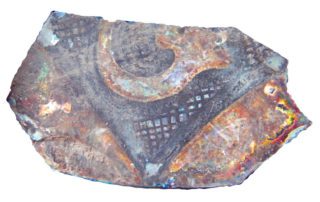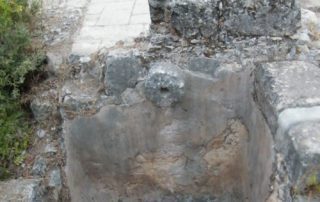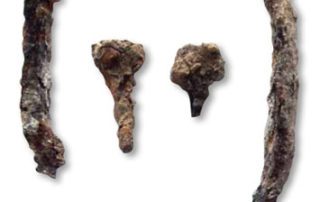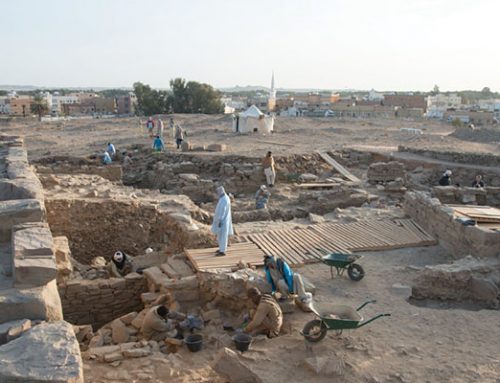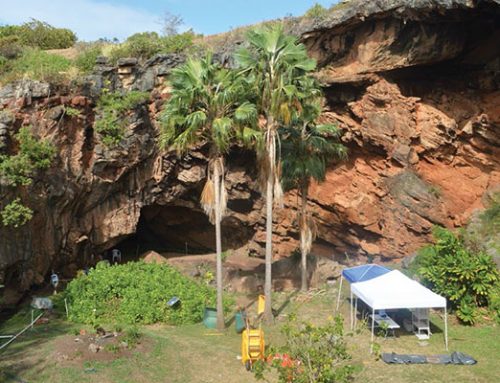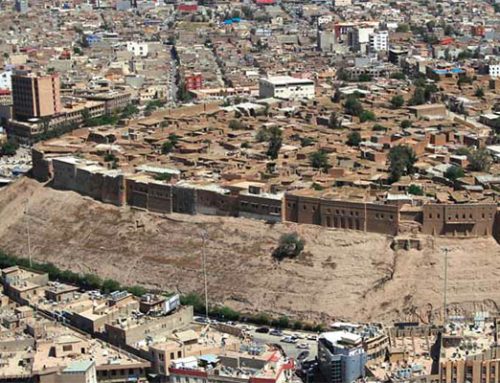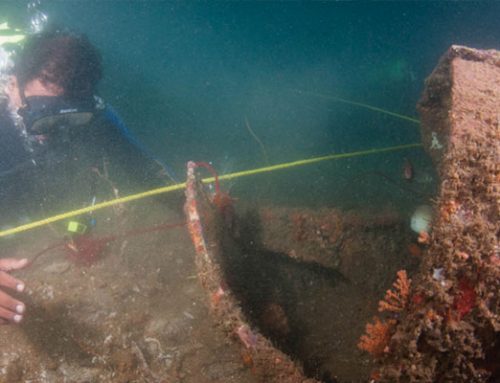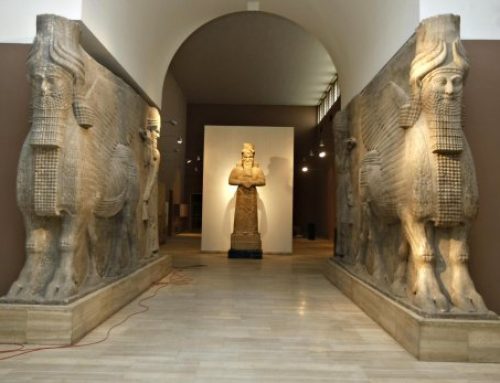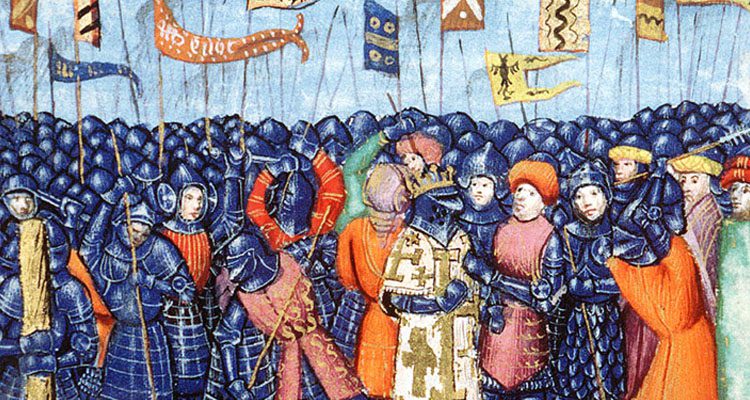
(Pictures from History/Bridgeman Images) This 13th-century French manuscript depicts the defeat of the Crusaders in 1187 at the Battle of Hattin by the Muslim leader Saladin. This established his military dominance in the Holy Land and triggered the Third Crusade.
A detailed picture of more than two centuries of European Christian life in the Holy Land is emerging from new excavations at monasteries, towns, cemeteries, and some of the world’s most enduring castles
“God wills it,” cried the crowd gathered on November 18, 1095, in the northern French city of Clermont in direct response to Pope Urban II’s entreaty that they come to the aid of their Christian brethren in the east. The Byzantine emperor Alexius I Comnenus, threatened by the growing power of the Seljuk Turks—who had already captured the important Christian cities of Antioch and Nicaea—had requested the pope’s help to defend his territory and keep the Turks from his capital at Constantinople. What began with a request for military assistance turned into a campaign to defend Christendom and reinstate Christian control over Jerusalem, which had been ruled by Muslims for more than three centuries.
Tens of thousands of people—from armored knights on horseback wearing tunics emblazoned with red crosses to ragtag bands of poor peasants, some of whom branded their flesh with the sign of the cross—set off the following year on the arduous trek of nearly 2,000 miles to the Holy Land. Only a century later did they become known as Crusaders, from the French term for “way of the cross,” and this first wave of Europeans was dubbed the First Crusade. After winning back Antioch and Nicaea, the Crusaders eventually seized Jerusalem on July 15, 1099, massacring all of its Jewish and Muslim residents—30,000 by one account—and leaving the city, holy to all three faiths, awash in blood.
The famously intolerant invaders established control over an area roughly the size of today’s Israel and West Bank, which they called the Kingdom of Jerusalem. In their wake, an array of Europeans—nobles, mercenaries, criminals, and pilgrims, among others—primarily from France and Germany, flooded into the Near East. For the next nearly 200 years, their power waxed and waned.
In the first century that they were there, they crowded into the region’s cities and established farms and vineyards in the countryside. Then, in 1187, they surrendered Jerusalem to the Muslim military leader Saladin. For the second century of their occupation, they were largely confined to a thin coastal strip along the Mediterranean Sea. By the time the often-fractured Muslim forces united to drive out the last Crusader in 1291, the Europeans had launched six major assaults on the Levant. This violent collision of European Christians and Middle Eastern Muslims took a terrible human toll and created a deep-seated antipathy that reverberates to this day. It also exposed a provincial western Europe emerging from the Dark Ages to a wider world filled with ancient cities, erudite scholars, and a vibrant new religion. In turn, the Crusaders left an indelible mark in the form of nearly 100 castles found across the modern states of Cyprus, Egypt, Israel, Jordan, Lebanon, Syria, and Turkey.
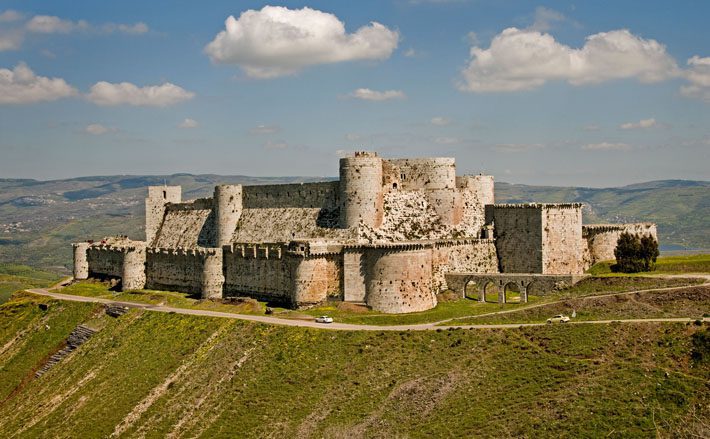
(Peter Horree/Alamy Stock Photo) Krak des Chevaliers in western Syria was built between 1142 and 1271 and is largely intact. It is one of the most striking of the nearly 100 Crusader castles found across the Middle East.
These medieval fortifications, coupled with the few written accounts left by Christian and Muslim sources, have long painted the Crusaders as little more than aggressive invaders focused on murder and plunder and uninterested in creativity or innovation, says Adrian Boas, an archaeologist at the University of Haifa. But he and a new generation of excavators are now uncovering a more nuanced picture of Crusader life from digs in castles, rural settlements, and urban areas, learning what they built, ate, and drank, how they fought, and even how they were buried during their long sojourn in the East.
In the summer of 1187, Saladin’s forces assembled on the shore of the Sea of Galilee 75 miles north of Jerusalem. The king of Jerusalem, Guy Lusignan, in turn, gathered his troops at a spring at Sepphoris to prepare for the battle. Sepphoris was considered the traditional site of the birth of Jesus’ mother Mary, at which time it was a thriving Roman city, and it served as a strategic watering hole for Greek, Roman, Byzantine, Arabic, and Ottoman travelers and armies through the millennia. Crusaders had used the area on and off for more than a century.
As some 20,000 cavalry and infantrymen readied themselves, the barons argued over whether to venture out on the plain to the east to attack Saladin, or to remain in the easily defended camp. The king chose to attack, and thousands of men set out on an extremely hot July day, carrying a standard containing a splinter of what they believed to be the True Cross. Raymond III, Count of Tripoli, had argued against the attack, possibly because he had a covert agreement with Saladin to support him as the next king of Jerusalem.
Outnumbered, exhausted, and short of water, the Crusaders were quickly crushed. Accounts note that, after heavy fighting, Raymond and his men fled north to safety.
Guy Lusignan was imprisoned at Damascus, and by October, Saladin had captured Jerusalem, although he refrained from massacring the city’s Christian population. Instead he expelled the Crusaders, who retreated to their coastal castles in Tyre and Tripoli in modern Lebanon. Europeans would never again regain full control over the holy city. When Pope Urban III heard the news, he is said to have died of grief. His successor promptly called for another Crusade to recover Jerusalem.
Just four years later, England’s Richard the Lionheart defeated Saladin, recovering many of the coastal cities such as Jaffa, Acre, and Antioch. After nearly capturing Jerusalem, the English leader negotiated a settlement with Saladin, granting Christians limited control over the city and a strip of land leading to the Mediterranean. This agreement infuriated many Crusaders and Muslims alike, and the peace did not last. For the next century, the outnumbered Europeans resorted as much to diplomacy as to fighting to retain control over their shrinking piece of land along the coast. They also focused on constructing fortresses to ensure their domination of the ports crucial for resupply and reinforcement.
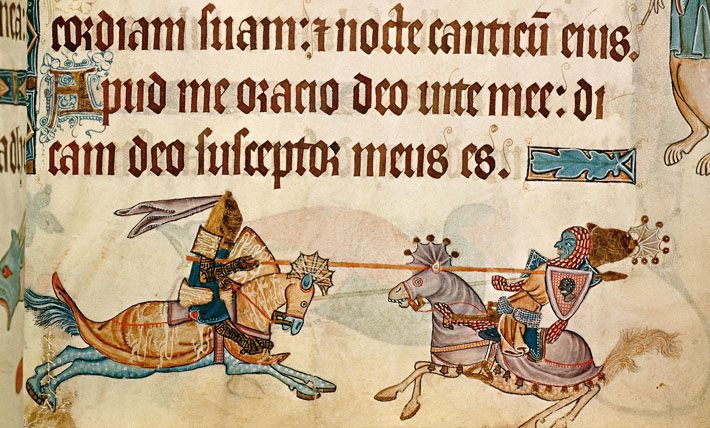
(Album/Art Resource) An illustrated miniature from a Gothic manuscript shows Richard the Lionheart (left) defeating Saladin (right) four years after the Muslim ruler had taken control of the Holy Land.
One of their most ambitious—and peculiar—works is located about 22 miles inland from Acre, the main Crusader stronghold on the coast. The castle, which sits high on a mountain, was built by the warrior monks of the Teutonic Order in the 1220s, a time when the Crusader kingdom was under increasing pressure from Muslim armies. These German men, who were typically of high status, had organized in Acre in 1190 to protect and care for Christian pilgrims to the Holy Land. They named the castle Starkenberg or “Strong Mountain,” although today it is known by its French name of Montfort. It was designed not to protect the surrounding area, but to serve as a private headquarters, archive, and treasury for the wealthy order.
Haifa University’s Boas launched an effort in 2011 to excavate Montfort, which today is found in the middle of an Israeli national park just south of the Lebanese border. A previous expedition had been undertaken in 1926 when New York’s Metropolitan Museum of Art sent a team to recover a suit of armor for the collection of its Department of Arms and Armor. That effort failed.
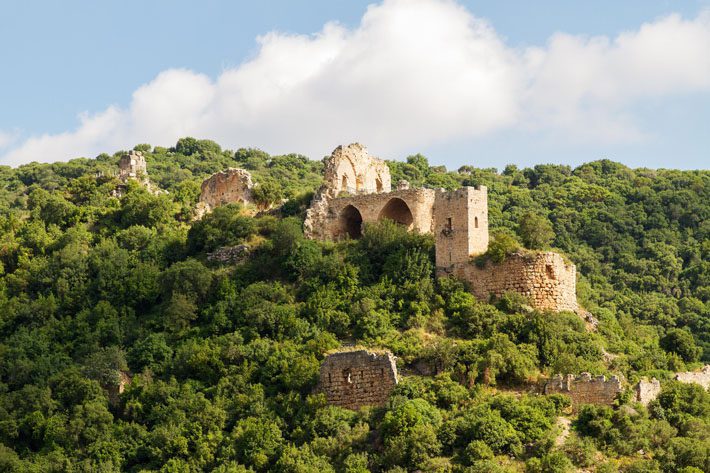
(Vitaly Suprun/Alamy Stock Photo) Montfort Castle, high in the mountains of the Upper Galilee, was built in the 1220s by the Teutonic Order to serve as their headquarters.
The sprawling complex of Montfort sits at the top of a rock-cut road, deeply scored to prevent carts carrying building stones that could weigh up to 10 tons from rolling downhill, according to Rabei Khamisy of the Israeli Antiquities Authority, who grew up in a nearby village and now directs the excavations. It was partially demolished less than a half century after its construction by Muslims intent on preventing a Crusader return. By digging through tons of debris and rock, the team has documented the castle’s design and decoration and cataloged a collection of small artifacts. The material they found contradicts the conventional view of Crusaders—and particularly of these warrior monks—as existing in crude conditions. Montfort, they discovered, was a formidable place of stylish living comparable to the fine manor houses and wealthier monasteries of its day in Europe.
The castle’s central keep is now just a wide stone platform with a few ruined walls made of gargantuan stones, but it once soared another 100 feet into the sky. Underneath, the archaeologists uncovered deep cellars for stocking supplies. Above the cellars they traced the remains of a finely plastered white floor and decorative pilasters of a large hall, as well as a chapel with an elegant apse that is still partially intact. The third floor once held sumptuous apartments for the order’s highest officer, the Grand Master. These boasted vaulted ceilings and frescoed walls decorated with gilded wood and punctuated with stained-glass windows, shards of which were found in the debris. “These were luxury accommodations,” says Khamisy. In a courtyard below the central keep a stone-carved wine press large enough to fit a small car still sits, evidence that local vineyards covered at least some of the terrain in the thirteenth century.
Along the southern section of the castle’s long outer wall, excavators working in a round tower in 2016 found an array of day-to-day artifacts, including iron waste from a forge and evidence of a workshop that turned bone into buttons and other objects. The discovery showed that there had been a thriving community of on-site artisans who supplied the knights with manufactured goods. The team also recovered a large number of glass fragments from delicate drinking vessels, a board for Nine Men’s Morris, a strategic game similar to checkers, along with the game pieces, and bones of European domesticated pigs, presumably brought by the knights to provide a taste of home.
On the mountain’s northern slope, the outer fortifications are topped with the only surviving Crusader wall crenellations known in the Middle East. Near the gate in the outer wall, which included a portcullis that could be lowered in case of a threat, the excavators uncovered remains of elaborate rooms complete with flagstone flooring and high ceilings supported by double-arched wood beams. The rooms were littered with rusty bits of horseshoes, horseshoe nails, bells, spades, axes, and saddling buckles and bells, along with thirteenth-century coins. Clearly, these were the castle’s stables. “Even the horses here lived well,” adds Khamisy.
Despite their seemingly impregnable mountaintop position, the end for the Teutonic knights at Montfort came quickly. The sultan Baibars, the Mamluk ruler of Egypt who had previously defeated the Mongol army at the Battle of Ain Jalut in 1260, took up Saladin’s campaign to rid the region of Crusaders. By this point, the Crusaders’ territories had contracted to just a few havens on the coast, and the castle was an isolated and vulnerable European outpost. Promised safe passage to Acre, the knights abandoned their headquarters after a two-week siege. Boas’ team has unearthed more than 40 stones weighing more than a ton each that were hurled at the castle by the sultan’s forces in 1271, as well as indications that some walls were undermined. The sultan had his men destroy much of the castle by burning so much wood that the resulting heat caused the building to collapse.
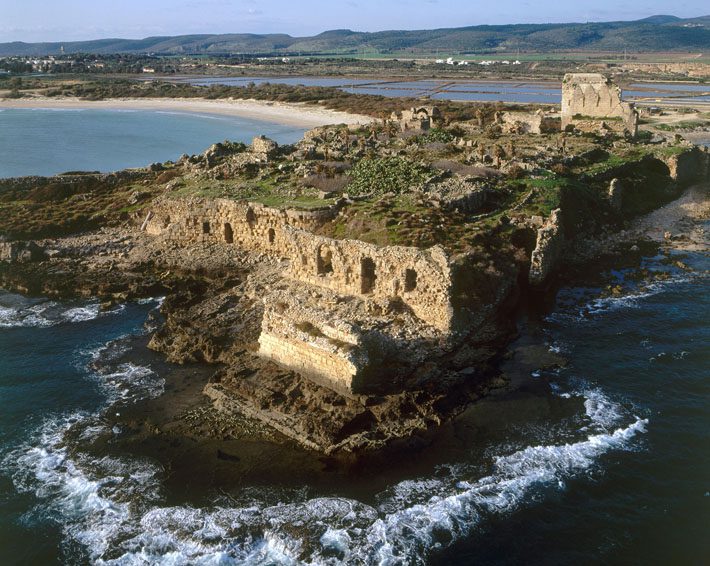
(Duby Tal/Albatross/Alamy Stock Photo) Athlit Castle was built by the Knights Templar beginning in 1218 to serve as a safe haven for pilgrims journeying to the Holy Land.
As the defeated knights marched to Acre under the watchful eyes of their Egyptian guards, a rival Christian order known as the Knights Templar still clung to control of an even larger and more ornate fortress. Built 50 miles south of Acre, on a rocky outcrop jutting into the Mediterranean, the structure, begun in 1218, was variously known as the Castle of the Son of God and Pilgrim’s Castle, and today is commonly called Athlit.
The Knights Templar, an organization far wealthier and more powerful than the Teutonic Order, was created in 1119 to guard and care for Christian pilgrims. These European knights maintained their headquarters on Jerusalem’s Temple Mount, known to Muslims as the Noble Sanctuary, until they were ousted in 1187. Nevertheless, they continued to expand their domain in the Levant throughout the Crusader era. They eventually became key financiers who garnered tremendous wealth and power in the Near East and in Europe until they were disbanded in 1307 by a jealous French king, Philip IV. Drawn to the area’s fertile fields, vineyards, and woods, and to the strategic harbor formed by a tongue of rocky land once used by Phoenicians more than 2,000 years before, the Templars built Athlit, a massive complex. To separate the mainland from the castle, they dug a wide, deep ditch that could be flooded with seawater from either side for defense, and then constructed a nearly 20-foot-thick wall that towered almost 50 feet high and was studded with watchtowers. An inner wall, twice as thick and reaching twice as high, protected the castle keep, which, according to contemporary sources, could house 4,000 soldiers.
Unlike their treatment of other Crusader forts such as Montfort, the Holy Land’s Muslim rulers left Athlit largely intact after the Europeans departed for the last time in 1291. Its impressive walls, though damaged by earthquakes and stone robbers, are still plainly visible along the train line linking Haifa with Tel Aviv. Until recently, however, the site has been as inaccessible to archaeologists as it once was to the Muslim armies who, for nearly a century, sought to capture the European stronghold. The castle’s ruins now sit inside the fences surrounding an Israeli naval commando base and are off-limits to civilians. Except for a brief British excavation in the 1930s, little research has been done on what Boas calls “the most remarkable and most notorious of Templar castles.” In 2017, Vardit Shotten-Hallel of the Israel Antiquities Authority gained access to Athlit after lengthy negotiations with the Israeli military.
The only contemporary description of Athlit comes from Oliver of Paderborn, a German chronicler and religious leader during the Fifth Crusade (1217–1221). He writes in his Historia Damiatina that Athlit’s builders had conducted their own sort of archaeological excavations. They stumbled on an ancient wall and found, “by the generosity of God,” a hoard of Hellenistic or Roman silver coins that helped pay off the cost of construction. The fortress, Oliver adds with maddening brevity, included a chapel, a palace, and “several houses.” He also shares that the Templar Grand Master resided for a time at the castle, and that the French queen Margaret of Provence—the only woman to lead a Crusade, after her husband, the king, was captured in Egypt—gave birth there around 1250. The queen’s apartments have yet to be identified. Later accounts mention that Athlit was the site of the Templar’s prison in the Holy Land, where, according to a contemporary report, two men accused of sodomy were sequestered in irons. Shotten-Hallel’s initial survey of the castle’s eastern tower revealed a long, narrow room with walls pierced by holes. Bar-Ilan University historian Yvonne Friedman suspects this may have been the prison, and that the holes accommodated iron shackles.
Devout pilgrims may have formed the largest group of visitors to Athlit. With Jerusalem inaccessible to Christians during much of the thirteenth century, the castle may have served as an alternate pilgrimage destination. Nobles, soldiers, and mercenaries accounted for only some of the Europeans who traveled to the Middle East in this era. In addition, thousands of pious pilgrims, from well-heeled merchants to penniless peasants, made the difficult journey in creaky ships threatened by storms and pirates in order to reach the Holy Land. The Catholic Church encouraged this flow by granting indulgences—remission of sin in the afterlife—to those who visited sacred sites there. According to the recollections of one pilgrim, the relics of the martyr Saint Euphemia were housed in the castle chapel at Athlit following their “miraculous translation” from Constantinople. After studying the chapel, which remains partially intact, Shotten-Hallel theorizes that it might have served as a kind of substitute Church of the Holy Sepulchre. The design, with a rotunda and twelve columns, resembles the Jerusalem shrine marking the place where Jesus is said to have been crucified and where his empty tomb is located. “It is as if they were creating a synthetic image of the holy city,” she says.
Athlit survived two major sieges and outlasted even Acre in the waning years of the thirteenth century as Muslim forces closed in on the increasingly isolated Crusaders. After the 1291 surrender of Acre, Athlit’s Templar defenders finally evacuated their fortress. They were among the last Europeans to leave the Holy Land. Most returned home, though a few Crusaders clung to the city of Tartus on the Syrian coast for another decade. The Kingdom of Jerusalem lingered on the island of Cyprus for another century or two, but efforts to use it as a launching pad for new Crusades failed. Those castles not destroyed by Muslim forces were repurposed to fend off future invasions. It would be another five centuries before a European army, this time led by French leader Napoleon, would again land on eastern Mediterranean shores.
